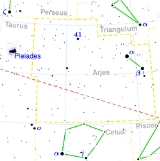
Gamma Arietis
Encyclopedia
Gamma Arietis is a triple star system, 204 light years distant, in the constellation
Aries
. It has the traditional name Mesarthim, of obscure origin, and has been called "the First Star in Aries" as having been at one time the nearest visible star to the equinoctial point. The name Mesarthim was from the Hebrew word mᵋshārᵋtīm, meaning "the minister", or the Arabic word Al Muthartim (ألمثرتم), meaning "the extremely fat ram".
In Chinese
, , meaning Bond
(asterism), refers to an asterism consisting of γ Arietis, β Arietis
and α Arietis. Consequently, α Arietis itself is known as
The system includes a binary star
with components separated with an angular distance
of 7.7 arcseconds (separable in small telescope
s). Both components are white A-type
main sequence
stars and have apparent magnitude
s of +4.75 and +4.83. The brighter is known as γ² Arietis and the dimmer γ¹ Arietis. The orbital period of the binary is greater than 5000 years. Orbiting the binary is γ Arietis C, a magnitude +9.6 K-type star located 221 arcseconds distant.
Robert Hooke
discovered that Gamma Arietis was made of multiple stars in 1664.
variable star
and its brightness varies by 0.04 magnitudes with a period of 2.61 days.
Constellation
In modern astronomy, a constellation is an internationally defined area of the celestial sphere. These areas are grouped around asterisms, patterns formed by prominent stars within apparent proximity to one another on Earth's night sky....
Aries
Aries (constellation)
Aries is one of the constellations of the zodiac, located between Pisces to the west and Taurus to the east. Its name is Latin for ram, and its symbol is , representing a ram's horns...
. It has the traditional name Mesarthim, of obscure origin, and has been called "the First Star in Aries" as having been at one time the nearest visible star to the equinoctial point. The name Mesarthim was from the Hebrew word mᵋshārᵋtīm, meaning "the minister", or the Arabic word Al Muthartim (ألمثرتم), meaning "the extremely fat ram".
In Chinese
Chinese language
The Chinese language is a language or language family consisting of varieties which are mutually intelligible to varying degrees. Originally the indigenous languages spoken by the Han Chinese in China, it forms one of the branches of Sino-Tibetan family of languages...
, , meaning Bond
Bond (Chinese constellation)
Leu sieu meaning "the Train of a garment", was one of the twenty-eight lunar mansions of the traditional Chinese astronomy. It was one of the White Tiger of the West (西方白虎).- The asterisms in the Region of Leu (婁宿天區):...
(asterism), refers to an asterism consisting of γ Arietis, β Arietis
Beta Arietis
Beta Arietis is a star in the constellation Aries, marking the Ram's second horn. It has the traditional name Sheratan , and the Flamsteed designation 6 Arietis...
and α Arietis. Consequently, α Arietis itself is known as
The system includes a binary star
Binary star
A binary star is a star system consisting of two stars orbiting around their common center of mass. The brighter star is called the primary and the other is its companion star, comes, or secondary...
with components separated with an angular distance
Angular distance
In mathematics and all natural sciences , the angular distance between two point objects, as observed from a location different from either of these objects, is the size of the angle between the two directions originating from...
of 7.7 arcseconds (separable in small telescope
Telescope
A telescope is an instrument that aids in the observation of remote objects by collecting electromagnetic radiation . The first known practical telescopes were invented in the Netherlands at the beginning of the 1600s , using glass lenses...
s). Both components are white A-type
Stellar classification
In astronomy, stellar classification is a classification of stars based on their spectral characteristics. The spectral class of a star is a designated class of a star describing the ionization of its chromosphere, what atomic excitations are most prominent in the light, giving an objective measure...
main sequence
Main sequence
The main sequence is a continuous and distinctive band of stars that appears on plots of stellar color versus brightness. These color-magnitude plots are known as Hertzsprung–Russell diagrams after their co-developers, Ejnar Hertzsprung and Henry Norris Russell...
stars and have apparent magnitude
Apparent magnitude
The apparent magnitude of a celestial body is a measure of its brightness as seen by an observer on Earth, adjusted to the value it would have in the absence of the atmosphere...
s of +4.75 and +4.83. The brighter is known as γ² Arietis and the dimmer γ¹ Arietis. The orbital period of the binary is greater than 5000 years. Orbiting the binary is γ Arietis C, a magnitude +9.6 K-type star located 221 arcseconds distant.
Robert Hooke
Robert Hooke
Robert Hooke FRS was an English natural philosopher, architect and polymath.His adult life comprised three distinct periods: as a scientific inquirer lacking money; achieving great wealth and standing through his reputation for hard work and scrupulous honesty following the great fire of 1666, but...
discovered that Gamma Arietis was made of multiple stars in 1664.
γ2 Arietis
The brightest component, γ² Arietis, is classified as an Alpha2 Canum Venaticorum typeAlpha2 Canum Venaticorum variable
An Alpha2 Canum Venaticorum variable is a type of variable star. These stars are chemically peculiar main sequence stars of spectral class B8p to A7p. They have strong magnetic fields and strong silicon, strontium, or chromium spectral lines...
variable star
Variable star
A star is classified as variable if its apparent magnitude as seen from Earth changes over time, whether the changes are due to variations in the star's actual luminosity, or to variations in the amount of the star's light that is blocked from reaching Earth...
and its brightness varies by 0.04 magnitudes with a period of 2.61 days.

